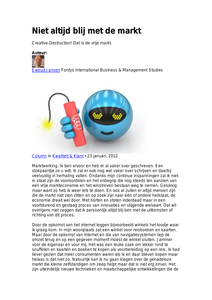Het is niet de taak van een bedrijf om zoveel mogelijk werkgelegenheid te scheppen. In tegendeel. Bedrijven moeten zorgen dat ze zo min mogelijk mensen nodig hebben.
DOCUMENT

Marktwerking is een prachtig mechanisme maar leidt ook wel eens tot het verlies van iets dierbaars.
DOCUMENT

Een neerslag van het onderzoek dat is gedaan door de leden van de onderzoeksgroep die verbonden is aan het lectoraat Creative Industries and Social Innovation
DOCUMENT

In this chapter, we propose that the democracy we wish to see out in the world is influenced by the quality of our own “inner democracies”—that is: the quality of the democracies among and between the selves or voices in the landscape of the self. We must find ways out of the I-prisons we experience and perpetuate. With this in mind, we propose that ”writing the self,” a method whereby creative, expressive, and reflective writing is used to cultivate an internal dialogue and construct a new identity narrative (Lengelle, 2014), can assist in reshaping our stories about ”the Other and ourselves” and can contribute to personal and cultural healing and reconciliation. The inner dialogue reconciled is foundational for the external dialogue at the heart of global citizenship within education. Indeed, as Schellhammer argues, we must cultivate the self in order to become inter-culturally competent, and this includes facing shadow aspects through truthful dialogues with the self and caring for the self. https://doi.org/10.1007/978-3-319-62861-5_6 LinkedIn: https://www.linkedin.com/in/reinekke-lengelle-phd-767a4322/
MULTIFILE

In order to become more innovative, corporations are increasingly turning to design-driven innovation capabilities. These capabilities are dynamic: they influence the way companies run their business and how companies create, capture and deliver value. Building design capabilities has proven difficult, given the tacit nature of design practice and the conflicting reasoning style of abduction that allows for the creative leap. However, if these enterprises don't improve, they are in danger of losing their ability to add value to the market. This may result in loss of market-share, which may lead to job destruction and the loss of valuable knowledge as communities of practice fall apart. This paper describes an iterative design process in which a tool was developed to determine which design-driven innovation capabilities a company is lacking. The tool started as a theoretical framework and was subsequently developed by prototyping with innovation managers from several large corporates. This paper contributes a new 'dynamic capabilities view' on design and innovation and a practical approach to implementing design in large firms. LinkedIn: https://www.linkedin.com/in/christine-de-lille-8039372/
DOCUMENT

Het polderoverleg is terug. Hopelijk betekent dit niet dat de sterkste lobyy het beleid gaat bepalen.
DOCUMENT
De toekomst van de boekhandel in het algemeen, en Polare in het bijzonder is onzeker.
LINK
1e alinea column: Organisaties bestaan in feite omdat ze goedkoper dan de markt samenwerking organiseren. Dit eenvoudige gegeven ligt onder vrijwel alle analyses van de impact van Internet: Internet verlaagt de externe markttransactiekosten. Interne coördinatiekosten van de organisatie moeten dus naar beneden op straffe van verdampen van de organisatie. Dat dat proces in volle gang is getuigen de vele kostenbesparingsprogramma's en reorganisaties bij (grote) ondernemingen. Die zullen ook niet meer ophouden, voorspel ik je en uiteindelijk zullen de meeste corporates hele andere organisatie vormen krijgen, gebaseerd op P2P crowdsouring en zelfsturing. Hier trend 3 van 6.
LINK
Most multi‑problem young adults (18–27 years old) have been exposed to childhood maltreatment and/or have been involved in juvenile delinquency and, therefore, could have had Child Protection Service (CPS) interference during childhood. The extent to which their childhood problems persist and evolve into young adult‑ hood may differ substantially among cases. This might indicate heterogeneous profiles of CPS risk factors. These pro‑ files may identify combinations of closely interrelated childhood problems which may warrant specific approaches for problem recognition and intervention in clinical practice. The aim of this study was to retrospectively identify distinct statistical classes based on CPS data of multi‑problem young adults in The Netherlands and to explore whether these classes were related to current psychological dysfunctioning and delinquent behaviour. This article is distributed under the terms of the Creative Commons Attribution 4.0 International License (http://creativecommons.org/licenses/by/4.0/).
MULTIFILE

This publication by Kathryn Best accompanied the Lector’s inauguration as head of the research group Cross-media, Brand, Reputation & Design Management (CBRD) in January 2011. The book outlines current debates around the Creative Industries, business and design education and the place of ’well being’ in society, the environment and the economy, before focusing in on the place for design thinking in creative and innovation processes, and how this is driving new applied research agendas and initiatives in education and industry.
DOCUMENT
